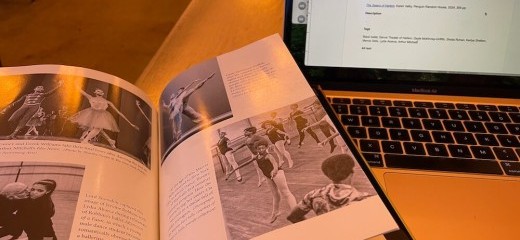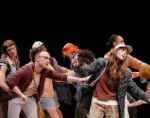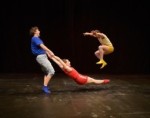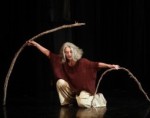
Remember Us: Five Groundbreaking Black Women Who Changed Ballet
By Ellen Miller
In The Swans of Harlem, Karen Valby retells a memorable moment for five of Dance Theatre of Harlem’s earliest ballerinas. They were invited to join Misty Copeland on stage to celebrate the release of her children’s book, Black Ballerinas: My Journey to Our Legacy, which highlights pioneering Black dancers. But there’s a catch: none of the five dancers, who were founding and first generation dancers at Dance Theatre of Harlem (DTH), were included in the book. At the time she wrote the book, Copeland (herself the first Black woman to rise to the rank of principal dancer at American Ballet Theater) didn’t know they existed.
DTH, the nation’s first all-Black ballet company, was founded by Arthur Mitchell in 1969. The Swans of Harlem sets out not to document Dance Theatre of Harlem’s history, but to record the stories of its original “swans,” or women dancers. The book is organized into three Acts: Act 1 covers the early years as the swans find their way to the company and the company finds its own way; Act 2 where the original swans leave the company to follow their own paths; and Act 3 these women’s efforts to reclaim their history, a journey they say is only just beginning.
The Swans of Harlem uplifts the voices of Lydia Abarca, Gayle McKinney-Griffith, Sheila Rohan, Karlya Shelton, and Marcia Sells. During the pandemic, the women, who refer to each other as sisters, reconnected as the 152nd Street Black Ballet Legacy Council, meeting by Zoom and sharing stories. Valby’s book, an outgrowth of their conversations, seamlessly integrates the history of Dance Theatre of Harlem with the history of these women, each of whom had their own path to the company – and from it.
In telling their stories the book necessarily confronts the racism experienced by different generations of Black women in ballet. Denied opportunities to study ballet, the founding dancers of DTH (Abarca, McKinney-Griffith, and Rohan) had little ballet training before joining the company as young women. At the time, colorism suffused the ballet world, even at a Black company. Abarca, often cast in principal roles, was lighter-skinned, which some allege contributed to her frequent casting over other talented darker-skinned dancers.
Sells, a first generation dancer who was able to study ballet as a child, recalls being referred to as a “dirty snowflake” by another child in the audience when she performed as a teenager with the Cincinnati Ballet. Shelton, one of the younger of the group, grew up as the only Black dancer in her classes in Colorado where she would never have considered sharing her experiences with racism, like the time the KKK came down the street when she was at a barbecue. When she visited New York City to audition for companies, she specifically sought an audition at DTH.
Within this complex environment, the swans were hardly passive participants. The dancers advocated to wear tights and shoes in their own skin tones, pioneered by Lanchie Stevenson, another founding member of DTH, who would layer brown tights with the feet cut off over her pink tights in class. While Mitchell was won over, adopting brown tights and shoes as a company-wide policy for performances, Stevenson was never credited for her idea at the time. It would be decades before more inclusive tones became more widely available– and accepted.
The Swans of Harlem details intimate, individual experiences such as Rohan relating how she kept her children a secret from Mitchell for over a year. McKinney-Griffith shares her conflicted experience as a dancer and eventually as DTH’s ballet mistress, and the pain she experienced when Mitchell cut her off after she left (temporarily and with his blessing, she believed) to join The Wiz. The pages of the book are filled with the women’s vulnerability as they discuss not only their journeys in dance but in life, touching on topics like alcoholism and abortion. It also introduces experiences and concepts worth deeper exploration elsewhere, for example the loss of many original DTH male dancers during the AIDS crisis.
Mitchell died in 2018. Since then, the women maintain they are more comfortable speaking candidly about their experiences. “I do believe that he would’ve tried to control us,” says Rohan. Valby explains, “It would have become the Arthur Mitchell story. Or the story of Dance Theatre of Harlem. The women would have remained in the background, interchangeable, replaceable.”
In beautifully documenting the journeys of five DTH dancers, Valby has ensured that a rising generation of ballerinas know them. And yet none of the five dancers in The Swans of Harlem are mentioned on the DTH website in its recitation of history or alumni. Who in dance gets remembered and how are their stories told? Organizations like Memoirs of Blacks in Ballet set out to do some of this work, but Valby reminds us it is upon all of us to determine whose stories get told and remembered.
The Swans of Harlem, Karen Valby, Penguin Random House, 2024, 304
Homepage Image Description: A copy of The Swans of Harlem stands next to an open laptop. The cover of the book is gold, with black and white photographs of five Black ballerinas in retiré, leaping, and posing in arabesque and with a pointed foot. The book’s subtitle is also visible on the cover: Five Black Ballerinas, Fifty Years of Sisterhood, and Their Reclamation of a Groundbreaking History.
Article Image Description: A copy of The Swans of Harlem is open on a table next to an open laptop. The book is open to a photo spread. The black-and-white images depict dancers from the early days of Dance Theatre of Harlem, including an image of Lydia Abarca being coached in Afternoon of a Faun, final bows, Gayle McKinney-Griffith being partnered in arabesque, and a photo of Marcia Sells in class at ten years old. Sells is jumping in second position with her feet pointed and arms outstretched, looking down towards her left hand.
By Ellen Miller
January 5, 2025










